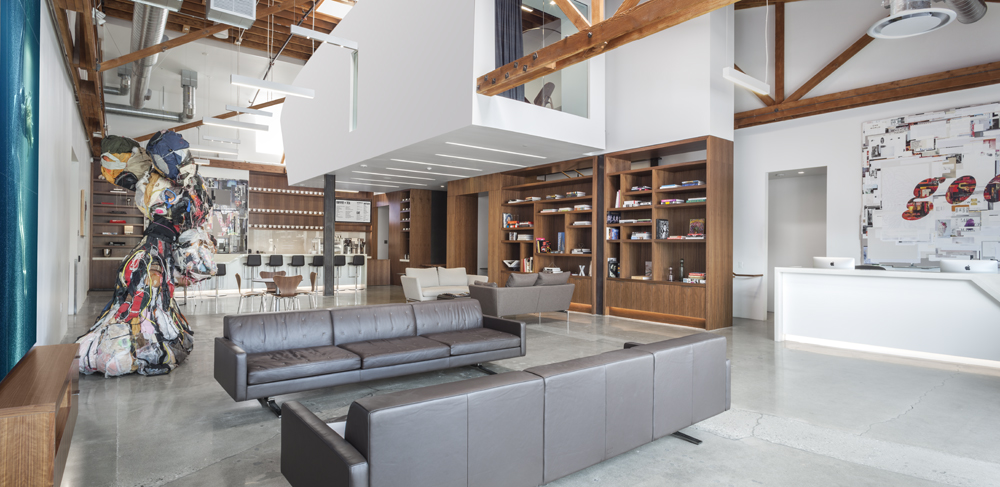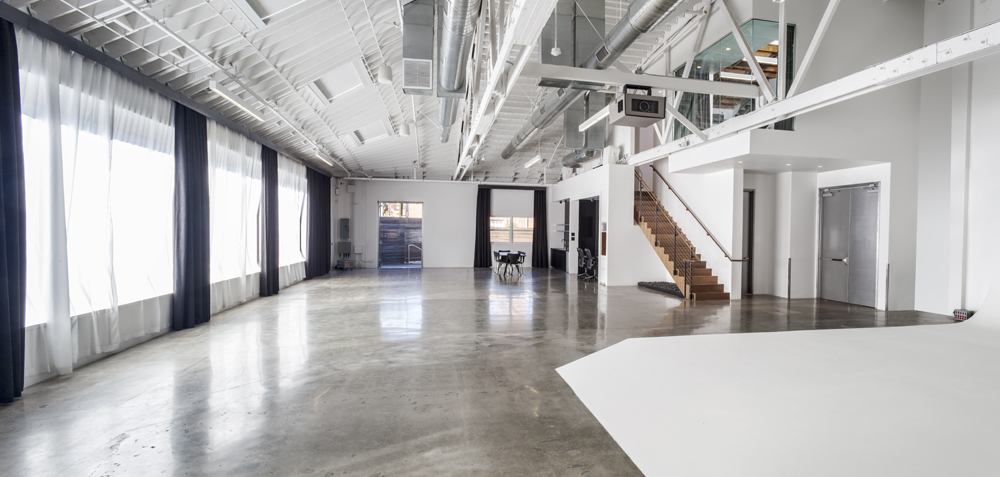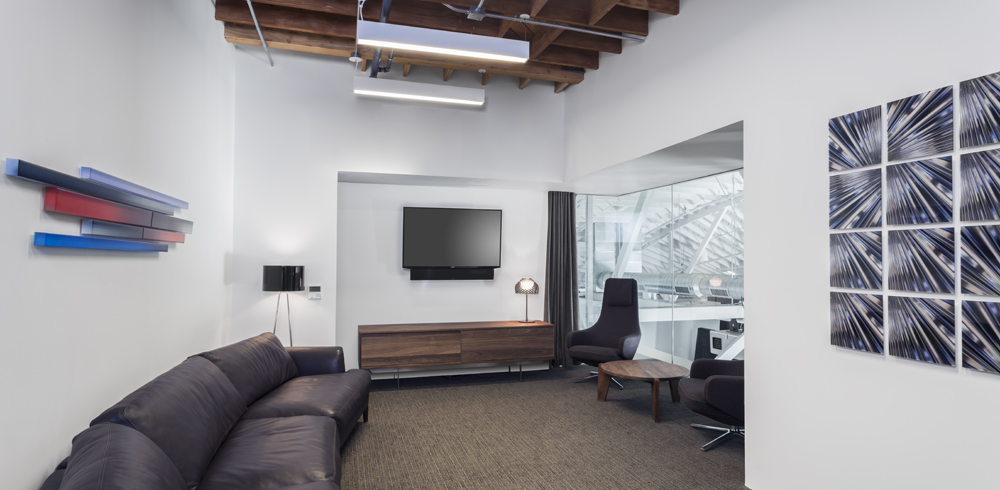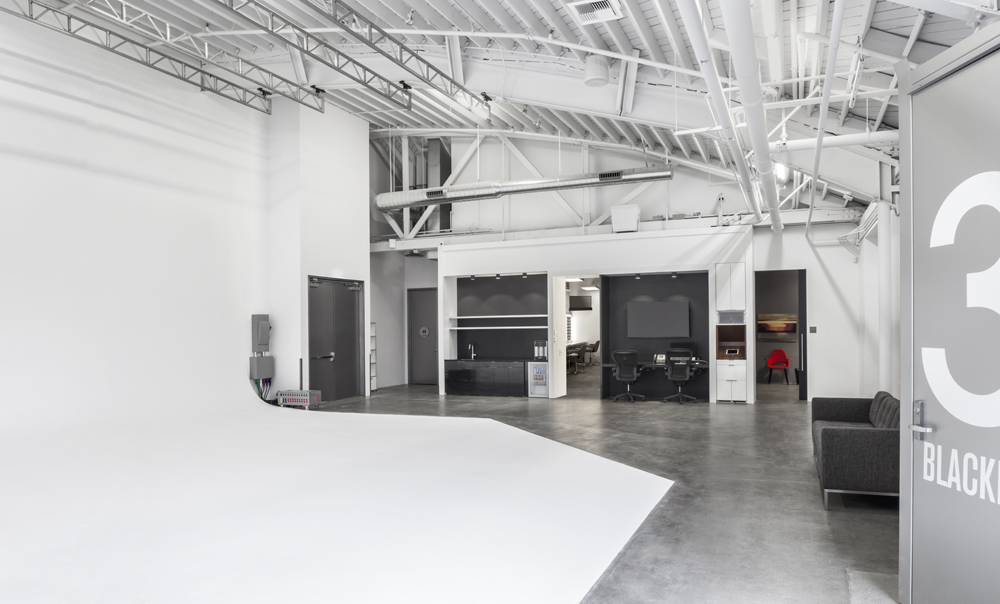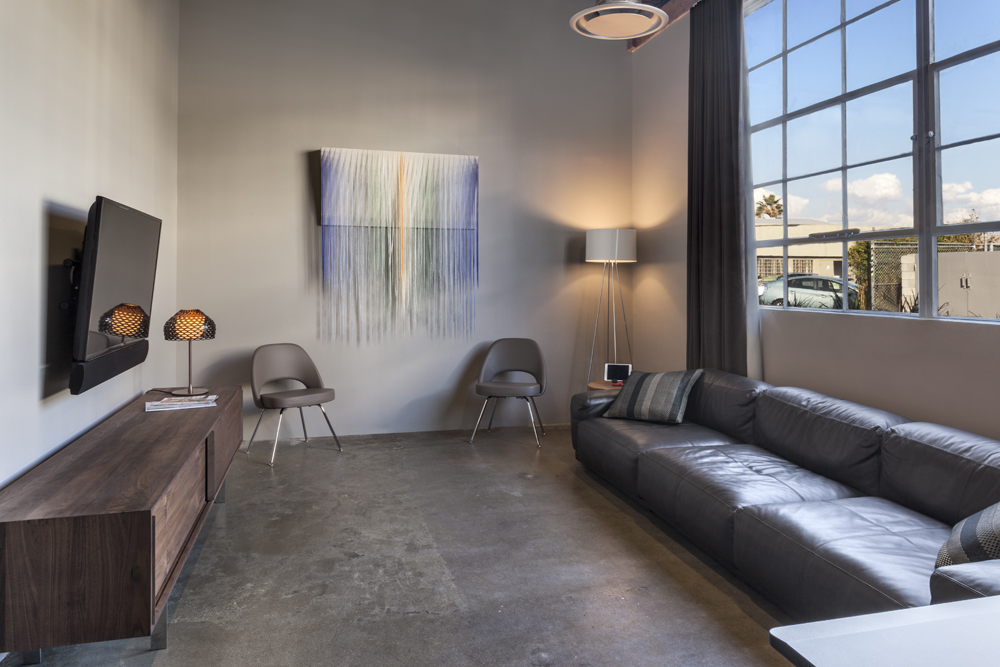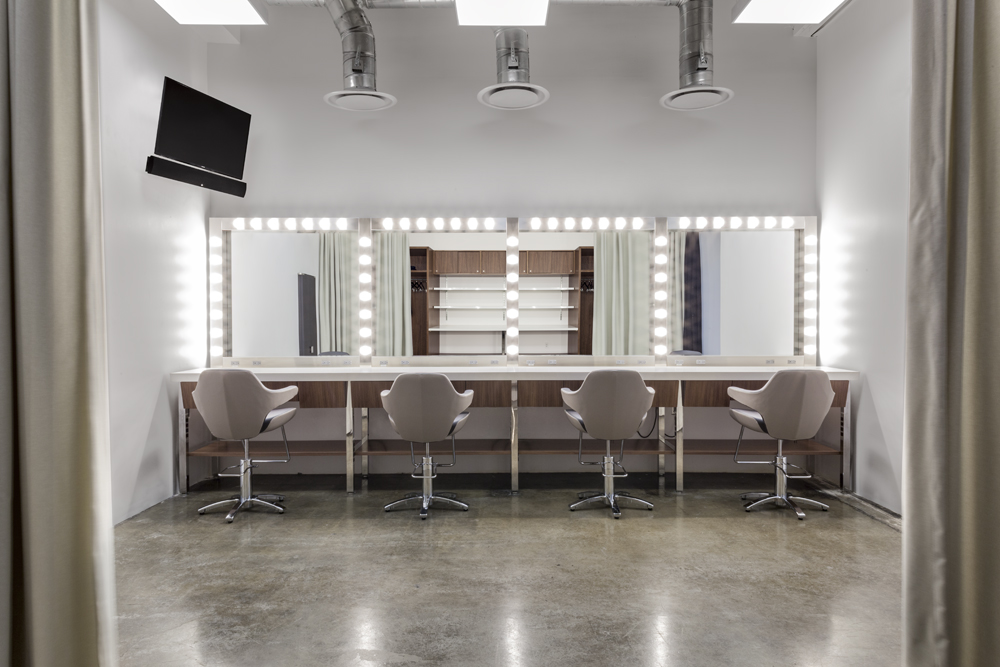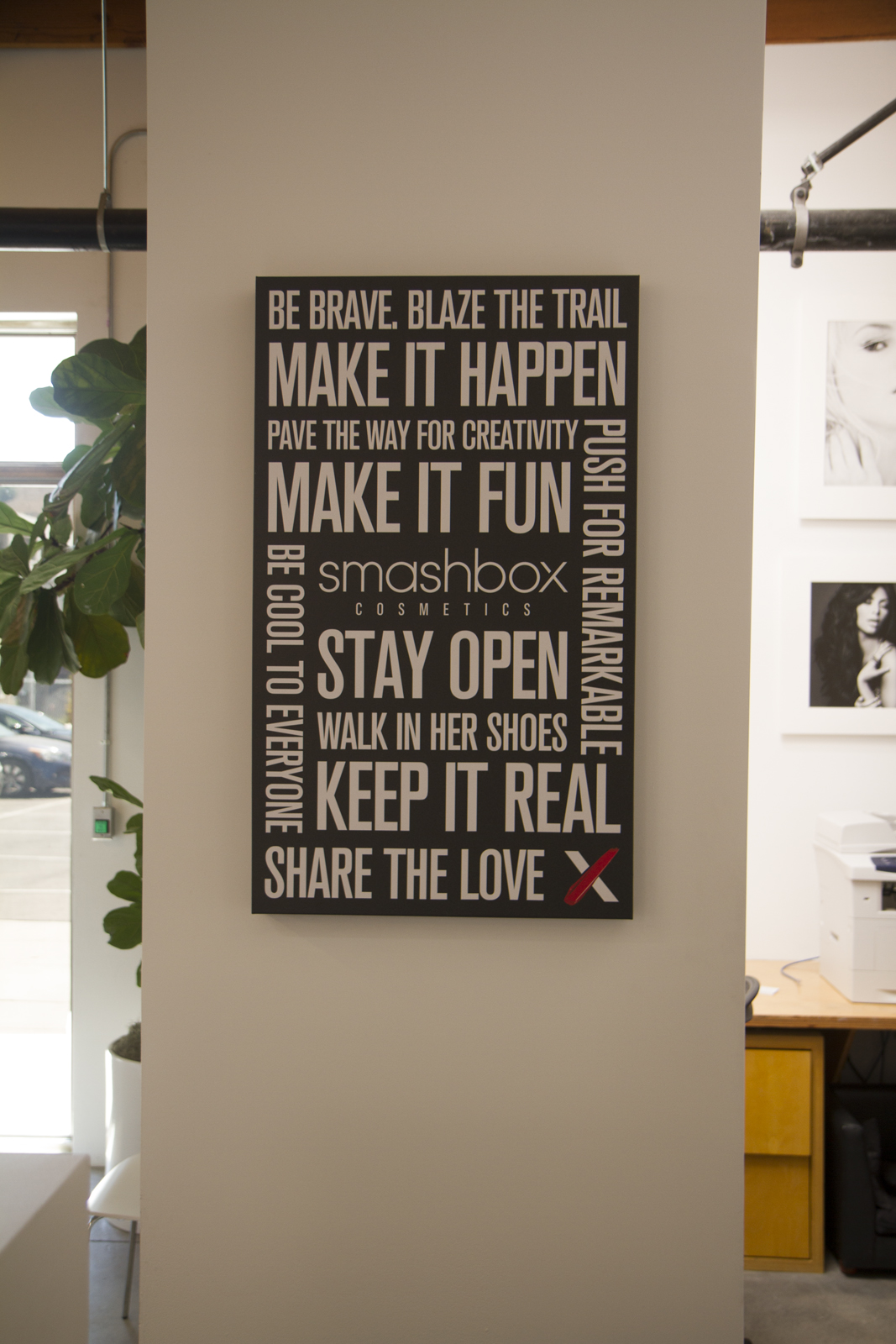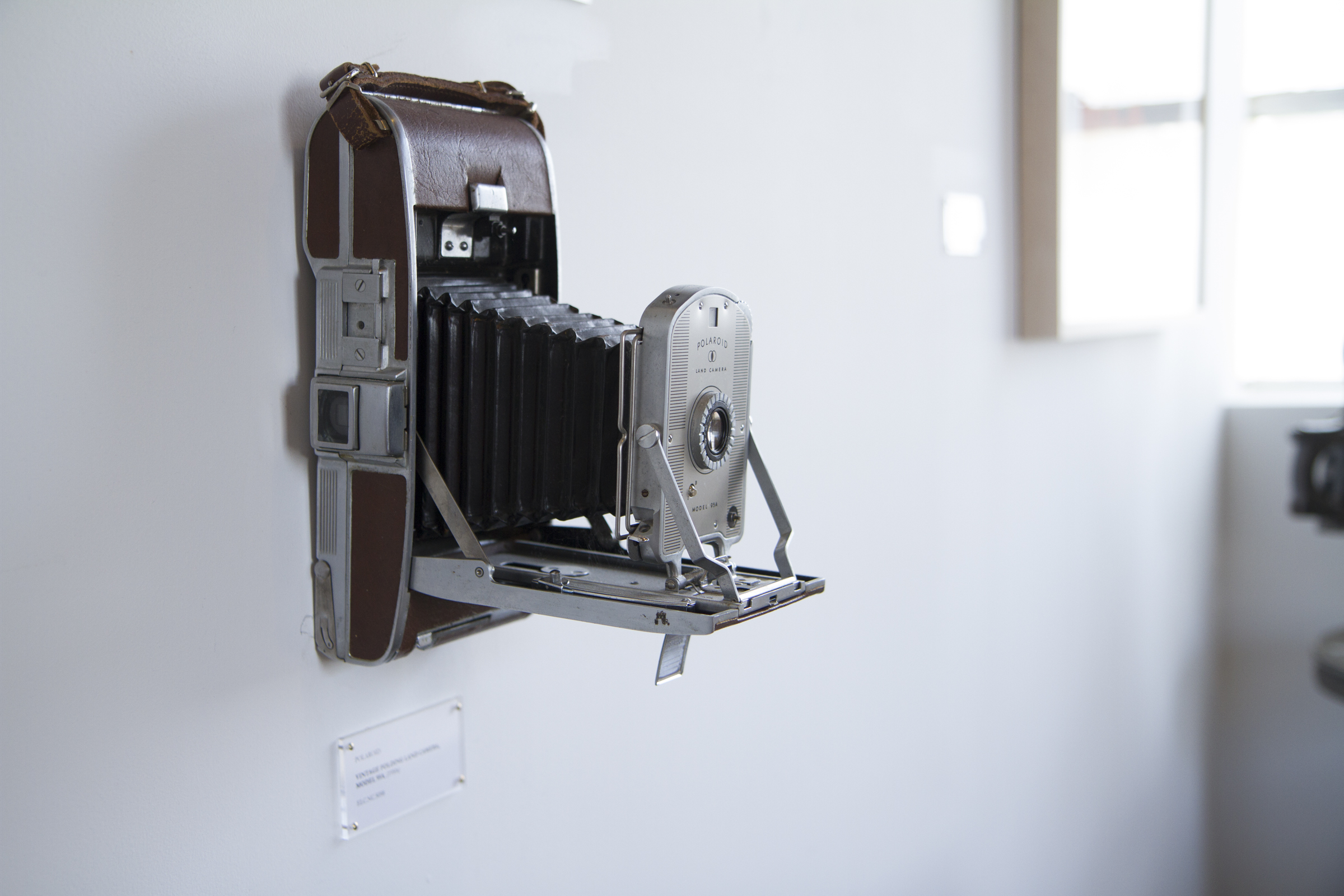Stop Competing With Your Co-Workers, It's Not Healthy
Because there is an “I” in competition.
Photo: Angelica Marie Photography for Create & Cultivate
A bout of healthy competition can be used to keep us on track and maintain our motivation, but how do we recognize when this feeling is no longer beneficial? We are all individuals with a unique skill set trying to advance in our careers, but when is competition no longer healthy? When our personal goals start to become greater than the goals of the company, or when our progress starts to be at the expense of a colleague, we have to reevaluate our motives us. What can we do when we start spelling TEAM with an “I?”
Below are four simple ways we can be better at using our competitive energy to benefit everyone on the team.
“I may excel at X, but I need to work on Y.”
As much as many type-A individuals may not like to admit it, we all have a set of weaknesses in addition to our strengths. Gasp! Jot down in your phone or notebook the skills you rock at and the tasks you could use an extra hand. Seek out a colleague who complements your skillset and work together on a project that requires both of your unique talents. It’s important to be honest with this task as the more truthful you are the more likely you will find a perfect match. The whole is greater than the sum of the parts!
“Where have you been all my life?”
In addition to discovering a complementary skillset amongst our colleagues, it can also be helpful to find a match from a social perspective. The more we get to know our co-workers personally, the less “threatening” they are. Discover common interests by grabbing a latte together on break or a glass of rosé after work… you never know, you may just meet a new friend. When we become friendly with our colleagues, their success will often become our own. Find your partner in crime!
“#Squad”
Now that you and your previous nemesis have become friendly and have complemented each other on a recent work project, it’s time to unite together long term! Discover each other’s personal goals within the company and unite together on common long-term business goals. This unity doesn’t only have to be with one other colleague but can include an entire #squad. There truly is strength in numbers.
“Let's celebrate.”
When we accomplish a goal or finally submit a project we have been working on for months, celebrating is part of the journey! As much as it’s enjoyable to celebrate our own personal success, the party is so much better when we can share the moment with an entire team. Following your next submission with your #squad, plan a special night at your favorite restaurant and soak in all the success that has been accomplished together. No such thing as a party for one!
About the Author: Blare June is a lifestyle blogger from Halifax, Nova Scotia. What makes Blare June's blog unique is that in addition to fashion she writes about mental illness, empowerment, and overall wellness. When Blare June isn't blogging, she is working as a physician specializing in psychiatry in Halifax. You can find Blare June on Instagram: @blarejune.
Love this story? Pin the below graphic to your Pinterest board.
This story was originally published on April 12, 2016, and has since been updated.
MORE ON THE BLOG
Dos and Don'ts for Overcoming the Worst Work Day Ever
When it feels like Monday all week long.
Written by: Crosby Noricks
From the outside, owning your own business means waking up each morning Cinderella-style; singing with the sunrise, adorable little bluebirds helping you to get dressed, a zippity doo dah of gratitude and oh yeah, great hair.
And sure, on those days when everything is humming along, professional independence is a bit like being the fairy godmother of your own life. But we all know life itself is no fairy tale. Some days, you wake up just not feeling it. at. all.
It could be the never-ending news cycle horrors, a fight with your main squeeze, a good morning panic attack (a recent study found that 72% of entrepreneurs surveyed cited a mental health concern, the struggle IS real), or a go-go-go couple of weeks that have left you tired in all the parts and places a human can be tired.
When something personal is affecting you professionally, try out some of these guidelines to help you persevere through those ups and downs.
After all, you still have to make sure someone is driving the carriage and paying attention to that midnight deadline.
Don’t resist reality
Sometimes it’s our unwillingness to accept what’s actually happening that ends up causing us the most pain. All that running from what’s going on makes moving on harder, not to mention leaves you wide open for an emotion-filled sneak attack when you least expect it. Often, you will immediately feel better when you clearly acknowledge your emotional attachment; “My dad is in the hospital and I am scared,” or “I wasn’t able to secure sponsorships during yesterday’s conference call and I’m second-guessing myself.” Get a handle on the root of the problem.
For Brand Consultant and Certified Coach Stacey Hagen, a tough spot is a call to go inward. “Since I'm ultimately responsible for the energy I bring and I don't want that energy influencing a client on a coaching call, I do my best to sort out whatever is going on prior to getting on a client call. I do this by meditating and journaling. It helps me clear my mind so I can show up fully and hold space.”
Ask yourself, “what do I need to do to feel better?” and start there. A quick 20-minute walk or bitch session with a friend who gets it can work wonders.
Do fix what you can
For circumstances where there’s miscommunication and frustration building between yourself and someone else, getting on the path to peace might be easier than you think. Consider the adage, “no one can resist a non-resistant person.” This phrase is one Relationship Coach and Therapist Kelli Adame uses to help her clients move into a non-resistant, acceptant flow around a challenging affair. She suggests, “the next time you’re dealing with a difficult interpersonal conflict, focus on validating the other person by making them right. Everyone has the right to feel and think whatever they want, after all. Making the other person feel heard is the first step toward de-escalating a situation and puts the other person in a better mindset to receive what you need to deliver.” Adame recommends using this language “I hear everything that you are saying and you have every right to that concern AND I’d like or I need (whatever you have to negotiate).”
Do tell those you trust
Now, it might not be the most professional of declarations but sometimes getting real with your network about certain challenges can deepen rapport.
For Alex Moresco, a Chicago-based entertainment publicist and star of the new original reality web series “PRGirl”, a Lyme Disease diagnosis in 2016 completely changed how she approached working with clients. “Working and balancing a chronic illness can be incredibly tricky, especially in a service based industry such as PR. I have been especially fortunate to work with clients that I now also call my friends, and who genuinely care about my wellbeing. It is imperative that I am transparent with clients about my limitation so I can set expectations and provide the best service possible.
Don’t silo yourself
You could go back to bed and wallow in whatever has you down. It’s your company after all, and if you need to close up shop to get your mind right before getting back in the game, it’s a viable option. However, there’s a fine line between hiding out and simply giving yourself some necessary, though temporary, down-time.
That said, the quickest way to stop self-pity is to focus on serving others. Making valuable business introductions or taking your new intern to lunch are all easy-effort acts to get outside yourself and into the feel-goods that doing for others sparks. For an instant uplifting mood boost, Adame loves to simply buy the person behind her in line coffee.
Whether you choose to shut down or power through, how you handle your rough days can shed light onto your values and expectations as a business owner, it also models to self-care for your own team, clients and partners. Not all situations or solutions are one-size fits all of course, but over time you’ll learn how to overcome not-so-ideal days with ease and grace and find a regimen for achieving happiness and professional sustainability that fits your personal needs and gets you back on track toward happily-ever-after.
Crosby Noricks is the founder and director of PR Couture, the sourcebook for fashion and lifestyle communicators. As part of the site’s own 10-year anniversary celebration, Crosby launched The Bespoke Communication Awards, a global online award program established to recognize excellence among agencies, in-house teams, individuals and brands.
MORE FROM OUR BLOG
The 4 Best Ways to Cope with a Panic Attack at Work
No, you're not having a heart attack.
Claire, a new graduate, recently scored her dream job: a junior editor at her favorite fashion magazine. Claire dreamed of this position ever since she flipped through glossy magazines as a teen. Claire spent every summer in college interning for the chance to be considered for this position and her hard work finally paid off! Everything was perfect......perfect until the third day on the job. It was early morning, Claire walked into her first round table meeting, prompt, with a large latte in hand. Eventually, Claire’s new colleagues started piling into the room, including the Editor-in-Chief. As they took their seats and the meeting started, a strong feeling came over Claire. She started feeling as though something was terribly wrong! Within seconds Claire felt short of breath (literally gasping for breath), her heart was racing, and sweat was running down her newly purchased blouse. What was happening? As Claire sat in her seat she thought: Am I having a heart attack? Am I going to die? Everyone is starting at me!
For all of you who have endured a similar episode likely know far too well what Claire experienced (it’s hard to forget if it happened to you). A panic attack occurs abruptly and often spontaneously ‘out of the blue’ as an intense feeling of fear and discomfort that reaches a peak within minutes. If that wasn’t enough, some of the following symptoms also occur simultaneously: chest pain, chest tightness, shortness of breath, trembling, sweating, nausea, dizzy, tingling and fear of losing control or “going crazy.”
Unfortunately, because such episodes occur ‘out of the blue,’ nowhere is off-limits; including your place of work. Panic attacks are gruesome, but can be even trickier to navigate while on the job. Below are 4 ways to cope when your body is hell-bent against cooperating with you!
"HOLY CRAP, I THINK I JUST HAD A HEART ATTACK?"
“Holy crap, I think I just had a heart attack?”
“Holy crap, I think I just had a heart attack?”
Due to the fact that these symptoms mimic many medical emergencies, it is not uncommon for those suffering to feel like they might be having a heart attack or dying. Often, those who endure their first panic attack will visit their local Emergency Room (ER) in order to get checked out….. and wouldn’t we all if we thought we just had a heart attack? Ask your family doctor for a pamphlet at your next appointment and educate yourself on what an attack looks like. Understanding panic is the first step in coping. Although such attacks can be incredibly uncomfortable, panic attacks are short lived and will come to an end.
“WELL HELLO PANIC. I CAN'T SAY IT IS NICE TO SEE YOU AGAIN."
Just when you thought that was over (as you hoped it was a one time occurrence), panic has decided to visit once again. Panic may have returned without an invite, but this time you are prepared and ready! Now that you know what your body is experiencing as a result of education (as per above), it is time for the next step: Acknowledgment. Like with all uninvited guests, it is polite to acknowledge any ‘unwanted’ presence. You can give your panic a name to minimize its impact.
"You can give your panic a name to minimize its impact."
Tweet this.
"MAY I EXCUSE MYSELF PLEASE?"
It is one thing to experience an attack in the comforts of your own home, but it is another to have a panic attack at the office. Many people suffer in silence for fear of being seen as ‘weak’ or ‘not cut out’ for the job. Although it is often expected that you leave your private life outside of the office, it can be helpful to let your boss and colleagues know when personal challenges may impact the job (do this carefully, and only reveal details you think are pertinent to your job). Giving your boss a heads-up makes it that much easier to leave a meeting abruptly. Making others aware prior to the next attack is not only helpful for lowering your distress level, but you may get a few helpful tips from others…..as it is highly likely others in the office are faced with a similar challenge.
"PANIC, YOU ARE NOW INTERFERING! GAME OVER!"
What is the different between having a panic attack and having a panic disorder? Panic attacks become a disorder when there is a significant and persistent amount of time (greater than one month) worrying about having another attack or possible consequences of an attack. Additionally, those who fear another attack often engage in significant maladaptive behavioral changes related to an attack (ex: absentee from work) as a way of coping with the fear. If you find yourself persistently worrying about another attack, so much that you avoid things that remind you of previous attacks, it’s time to seek help!
Blare June is a lifestyle blogger from Halifax, Nova Scotia. What makes Blare June's blog unique is that in addition to fashion she writes about mental illness, empowerment, and overall wellness. When Blare June isn't blogging, she is working as a physician specializing in psychiatry in Halifax. You can find Blare June online atwww.blarejune.com or on Instagram: @blarejune.
We Need to Talk: Drawing the Line Between 'Casual Office Environment' and Harassment
When it's not OK.
I was 15 riding in my dad’s red Mercedes sedan. A car I would later inherit and subsequently total because LA drivers don’t know how to handle the rain. It’s a tragically true stereotype.
Less stereotypical was the conversation that occurred that night between D ole D and me-- the first and only “sex” talk I would get from my father, who probably wished that there was a roadmap as trusty as the Thomas Guide in our backseat, for this convo. Not so. Instead of warning me against the wily advances of Thomases or Tylers, my dad meandered around the topic, finally landing on this odd nugget: “I want you to know that women can be predators too.” I was a sophomore at an all-girls school so the advice wasn’t entirely misplaced, but it was still “so random, so weird.” Which is what I groaned before I stared out the window, unable to make eye-contact. Predator. Not a small word. Pretty aggressive now that I think of it. In a way, looking back at it, this was gender equality at kinda sorta work--my dad thinking that women were equally as capable as men of sexual harassment (though statistically, at least in the workplace, this is not true.)
More than 15 years later that conversation is only now starting to make sense.
In 2016, of the 6,758 sexual harassment charges filed with the EOC, only 16.6% of those were by males. The data do not differentiate between sexual harassment suits between men and women or those of a same sex nature (i.e. a female superior harassing a female employee). Other studies have found that 1 in 3 women between the ages 18-34 report being sexually harassed at work, but over 70% of those women do not report it.
Consider the number of female-to-female or male-to-male cases even more under-reported.
###
There have been many high-profile cases of male CEOs harassing female workers. Though American Apparel had its unitard ass dragged through the mud thanks to ousted CEO Dov Charney, a former female employee we spoke with said many of the women in executive positions weren’t much better. “When I was at American Apparel,” shared the 30-year-old who works for a new company, “a lot of the leadership was female and all the worst stereotypes about women were evident-cattiness, competitive, emotional-it was so sad to see.”
Derogatory comments about other women’s looks and bodies were common, as was slut-shaming was. “So much shit-talking,” the former AA employee shared. “Non-stop.”
Another source who works in interior design and asked to remain anonymous had this to say: “I personally feel like female superiors do sexually harass juniors, in my profession at least. Just not in the same way as the men. The men are condescending, belittling, and overtly sexual. They hold ‘meetings’ at strip clubs. And they make comments about women in general, if not specifically. The women are territorial.”
She continued, “And women make comments that in my mind--and this has happened personally--would constitute sexual harassment of the slut-shaming variety. Which is a different way of also establishing dominance and superiority. I think women have a really hard time with that. And will until it's a more equal distribution of men and women.”
"Female to female harassment simply reinforces the traditional patriarchal power structure."
Tweet this.
Which brings up a very important point. As women, we are still navigating what it looks like to have women in charge and, what it looks like to have office environments that are almost entirely female. This has been called the golden age for female entrepreneurship. Women are starting businesses at rapid rates. According to the 2016 State of Women-Owned Business Report it is estimated that there are now 11.3 million women-owned businesses in the United States, employing nearly 9 million people. Female leaders are also navigating a double-edged sword of quelling micro-aggression amongst females and harassment, with the the millennial desire to work in more casual environments. For instance, LinkedIn found that 67% of millennials are likely to share personal details including salary, relationships and family issues with co-workers. One-third of millennials think socializing with coworkers will help them move up the ladder. And 28% millennials have texted a manager out of work hours for a non-work related issue. Granted, those texts don’t have to be of a sexual or inappropriate nature, but many of us are confused about what’s OK and what’s not.
And there isn’t much of a precedent set.
Legally, according to Eisenberg & Baum, LLP there's this:
“The first United States Supreme Court decision acknowledging sexual harassment as a legal cause of action under Title VII came in 1986 with the case of Meritor Savings Bank v. Vinson. That case presented what would now be seen as a classic example of sexual harassment in which a female employee was coerced into participating in sexual acts by her male boss. Over ten years after the Supreme Court’s decision in Meritor, the Supreme Court considered the question of whether Title VII could apply when the harasser and victim are the same gender. In that case, Oncale v. Sundowner Offshore Services, Inc., a male worker on an offshore oil platform complained about the harassing conduct of several male co-workers who allegedly engaged in both verbal and physical sexual conduct with him. The Court noted that Title VII protects both men and women from discrimination based on their sex, and held that sexual harassment by someone of the same gender can be just as illegal as harassment by a member of the opposite sex.”
Just as illegal, but much murkier. Even though it shouldn’t be. Harassment is harassment is harassment. But in these female-first-we-all-champion-each-other times, where do we draw the line between ‘casual and fun’ and harassment?
I’ve worked for horrible male bosses where harassment has been horribly apparent. Those who have thrown trash at my head and told me to pick it up. One who told me he wanted to photo recreate Jesus’ crucifixion with me as the female Jesus. “You kind of look like him,” he told me. Whatever that meant. CLEARLY NOT OK. Bosses who used the word cunt to refer to female clients as casually as a conjunction. When I was pregnant, an employer told me to get married or get rid of the baby because, “I shouldn’t bring a bastard child into this world.” NEVER OK. When it comes to bad female bosses, the behavior hasn’t been as egregious. No female boss ever asked to tie me naked to a cross, that’s for sure. To be honest, I’ve had female bosses I definitely didn’t like, but I am way more hesitant to claim harassment. But in the past week numerous stories have come out about former Thinx CEO Miki Agrawal (a woman C&C has interviewed and supported) and more questions are being asked about what really is appropriate at the office.
Part of the problem lies in our overshare culture. Unlike economics, its effects have trickled into the workplace. The workplace is considerably more open, but sexual harassment laws are considerably more rigorous than they were pre-Anita Hill. It has been an uphill battle. In the 1920s women who couldn’t take the inevitable harassment were advised to quit their jobs. The term sexual harassment wasn’t even coined until 1975 when a group of women at Cornell University called it into being. In the early ‘90s, the American public was still in the midst of figuring out what was and was not acceptable. Finally, in 1998 (and the above mentioned case) the Supreme Court ruled that same-sex harassment was also illegal.
We accept this as truth and yet, when it comes to the current office culture (especially for women), we’re still in funky water. Like we know it’s good for us, but still smells weird. Like Bikram. We openly talk about our periods and sex lives. When we swiped right and where they subsequently swiped. We discuss it on our platforms. We champion truth-telling. We applaud bosses who are forthcoming and girls’ girls and encourage open environments. Until we don’t.
These cases are more rare, but they do happen. In January 2013, a sexual harassment lawsuit involving two women was filed by an Armani employee accusing her boss of unwanted sexual advances. In 2014, one of the biggest cases of same sex harassment involving a female Yahoo executive drew national attention. Maria Zhang, a senior engineering director for Yahoo Mobile, was accused by her subordinate Nan Shi, of allegedly pressuring Shi into having oral and cyber-sex in exchange for a “bright future” at Yahoo. There was a 2014 case against a Wells Fargo superior.
Now, there are some very clear lines in the sand. Touching, for one. Inappropriate comments as well. But there are countless examples of what a female boss might say to a female employee that would be considered harassment if said by a male, but we are generally more lenient with female bosses. I don’t know if that’s a good thing or a bad thing. I work at a company of all women and I feel free to speak my mind, almost all of the time. I feel safe. There's the 'every company is different' argument, but that feels like a cop-out and also, hypocritical.
As disturbing as that is, that’s not the biggest problem. The biggest problem is that every time women abuse their position of power, we undermine the equality we’ve set out to gain. Female to female harassment simply reinforces the traditional patriarchal power structure.
Which, brings me back to my dad, oddly enough. Women can be predators, too. It’s not fun to think about, but that doesn’t make it less true. It may be statistically less likely. It may not happen to 1 in 3, but it’s still happening. And it’s on other women to call it out.
That’s how we support each other. That’s how we get stronger.
Arianna Schioldager is Create & Cultivate's editorial director.
Have thoughts? Please share in the comments below. We're listening.
MORE FROM OUR BLOG
Touring the Legendary Smashbox Studios
After 25 years, it's as smashing as ever.
In 2015 Smashbox Studios in Culver City got a 5 million dollar major makeover. The legendary 25,000-square foot space with 22-foot ceilings has played host to countless photo shoots, video productions, parties. It's been a innovative and inspiring pillar in the artistic community for over 25 years.
A bright environment, bustling with creative energy, the studio is the perfect setting for collaborative magic to take place-- one of the reasons the offices are also located at the studio. Davis Factor, photographer and founder of Smashbox says, "These amazing fashion events go on all around us. There’s a creative energy here that’s unlike any place I’ve ever been.”
Ginny Chien, Executive Director, Global Consumer Marketing, says of working with the company, “Check the egos at the door. You have to come in, be open, accept the fact that you work with some outstanding people, and jump right into it.”
In 1996, Smashbox launched Smashbox Cosmetics, a makeup line developed to meet the demanding needs of their shoots. It's the only beauty brand born out of a real studio. But as Factor says, “This is a real place. We have makeup that we’re using on trendsetters every single day, and everyone gets a piece of that. No other cosmetics brand can make that claim: created, tested and photographed at a real studio."
Take a tour of the Smashbox offices above.
More from our blog:
Kelly Ripa Is Not a Diva For Taking the Week Off
How to handle getting blindsided at work.
We've all found ourselves in tricky work situations. An unexpected firing. A demotion. A bad performance review when you were expecting a glowing one. When your boss hires outside talent for the job you were gunning for. (But you were promised they promoted from within!!)
It's always "difficult" to process (read as: fire alarms, bells ringing, hot body, time moving differently and slow) when a bomb gets dropped on you in the office. But these kinds of situations don't only happy to lower-level employees. Even the top dogs get "blindsided."
Case in point: Kelly Ripa. Last week after Tuesday's taping of Live! With Kelly and Michael, the longtime host was called into a meeting where she was told her co-host, Michael Strahan would be leaving to take a full-time role at Good Morning America. The next day Ripa was not on set when Strahan announced his departure alongside Ripa's stand-in, Ana Gasteyer of Saturday Night Live fame. And that's when the media went ham on Ripa, who was labeled as a "diva" for taking the rest of the week off.
“She is acting like a child, a diva and hurting her reputation with this sort of behavior,” a source told the Daily News. “It makes her look bad and makes all the horrible rumors about her bad attitude off camera seem true.” But is diva the right word? Not exactly, but we'll split hairs over that another time.
Voice of reason, Oprah, came to Ripa’s defense, telling Entertainment Tonight: “Blindsided is never good. I don’t know who’s in charge, but somebody should’ve said, ‘This is gonna happen.’ You shouldn’t have to read it in the paper. Ever.”
1. HAVE THE INITIAL EMOTIONAL RESPONSE SOLO
It's OK if you get emotional about office politics. Robots and machines haven't replaced us in all capacities after all. And while we don't think you necessarily have to step outside to cry, if you are going to have an emotional response, it's best to do outside the presence of your co-workers or boss. No matter what, it looks unprofessional to have a fit-- even if it's justified. This is the time to phone a friend. (Or if you're in a position like Kelly, take a few days off-- a luxury we understand is not available to all.) And then approach the situation with a cool head.
2. TRY TO SEE IT FROM BOTH SIDES OF THE TABLE
You're mad as hell. We get it. For Ripa, this was the second time in her career similar events occurred. In 2011 Regis Philbin also informed Ripa of his departure 20 minutes before announcing it live on air. It's not great to feel so disrespected in the workplace, especially when you are clearly dedicated to your job. However, if and when possible, think about the possible reasons as to why the blindsiding occurred. It may help alleviate some of the anger, and actually motivate you to do better.
3. SET A MEETING AND ASK SOME QUESTIONS
If you don't know how you're doing, ASK. If, instead of promoting from within, your company brought in outside talent-- ASK WHY. Instead of brooding in the corner with your headphones on and talking smack at the Nepresso machine, set a meeting and ask specifics. Your boss has expectations of you, but that doesn't mean you aren't allowed to have expectations from the company-- especially if they were discussed as options upon hiring.
"Your boss has expectations of you, but that doesn't mean you aren't allowed to have expectations of them."
Tweet this.
You can't always know when it's going to rain, but you can always have an umbrella in your trunk. The more prepared you are, the better your chances of dodging the droplets.
More from our blog:
Making Statements: Your Guide to Being Bold in the Office
Power dressing leads to power moves.
STANDING OUT IN THE WORK CROWD.
It's a tricky balance, because what you want is to be a team player while also advancing your career and showing that you're bold as brass. Or perhaps diamonds, in the case of Simon G. The jewelry company knows all about making statements-- from pieces that celebrate achievements and love, to brilliant necklaces that elevate an entire outfit.
We're breaking down the 6 ways you can be bold in the office.
1. POWER POSING IS GOOD FOR THE BRAIN AND BODY
Online, content in king. In person, it’s confidence. One of the best ways to “fake it till you make it” is with your stance. Your body language has been proven to shape who you are, affecting everything from the way people view you and your intelligence to the way you speak. The most common power pose is “opened up” and indicates a position of control. Instead of a closed off body language that communicates a more meek personality.
A power pose can actually change the way you view yourself, even change your body chemistry. Posing for just two minutes can increase your risk tolerance, which makes for bolder and more executive office decisions.
2. POWER DRESSING, WELL THAT ALSO MATTERS
When you look good, you feel good. And making a statement when getting dressed to go before the board or you boss can be as simple as adding a Simon G. necklace that says, my outfit is boss, and so are my ideas. A successful work uniform saves time, energy, and also lets people know what kind of work you do.
There’s a reason it’s called dressing to impress: it works. You project confidence and earn the trust of people entrusting you to get the job done.
Fabled Collection Pendant, 18K Rose Gold - $3,740 USD
3. ESTABLISH YOUR CONFIDENCE EARLY
Everyone claims to love the story of the girl who came into her own, but in truth, it’s much more impressive to own the room or a job without being primped. If you’re about to host a meeting, set an agenda, talk about priorities, and ideas moving forward in order for your team to work most efficiently.
If you have expectations or if goals are changing, put those on the table. The tone you set is crucial for not only establishing confidence but also getting the results you want.
You are in charge. So act like it.
4. DON’T FORGET WHERE YOU CAME FROM
This may feel counterintuitive but it’s so important to bring your past into your present, and allow it to inform your future. In fact, confident but humble is the way to go when it comes to power moves. Being bold doesn’t mean having an ego about what you do, and it certainly doesn’t mean that it’s an excuse to belittle your team or workmates.
You’re only as good as your team, whether you’re at the top of the ladder or the bottom. Sparkle and shine in the office or at a meeting in a piece like this from Simon G., while remembering your roots.
Caviar Collection Pendant, 18K White Gold - $5,280
5. SHOW, DON’T TELL THE WHY AND HOW YOU’RE A UNIQUE ASSET.
Like a gorgeous piece of statement jewelry that speaks for itself, you need to make sure that you are engaging your peers with tangibles without telling them why you’re great at your job.
Show them with success. Meeting booked. Partnership deals in the works. A cold call that proves you have the stomach to be fearless.
6. LOOK AHEAD, INSTEAD OF AROUND YOU
This is simple: comparison is the thief of joy, but it’s also the buzzkill of confidence, and ultimately success. Own the position you’ve found yourself in and you’ll find that all of the sudden you’re no longer faking it.
(And when in doubt or you feel yourself feeling not so bold, ring up a mentor who will tell you next steps.)
The 6 Personality Types Every Startup Needs
You're only as good as your team.
Your startup is your tribe.
You spend more time with them than you do with your family (#sorrymom). There are shared lunches and late hours and at certain points, you all wear every single hat. Because when you’re working to build something together, you switch hats, pants, shoes; the words “I can’t do that,” are not part of your vocabulary. In many ways each of you is the "ideal worker"-- something that gender and labor scholars have identified as the person who shows up early, leaves late, never says no, never gets sick, answers emails morning, noon, night, weekends, makes every meeting, is a go-getter, ad infinitum. These are employees who work hard and challenge themselves on a daily basis. In a dream world, every team member of your start-up is that person.
Here on earth however, there are specific people that fit better into certain roles and make the squad function like a well-oiled machine.
THE VISIONARY
Often the CEO. They think big and small, they see far ahead but also catch the tiniest of details right in the moment; the little things you would never even notice. Nothing gets past them, but it's because the Visionary knows how they want to see their vision executed. Thinking outside-the-box is one part of their supernatural abilities. They are highly-functional, fast-paced, and fastidious. "The ways in which people consume everything," says Jaclyn Johnson, Founder and CEO, "has changed significantly. So if we are not evolving, we are not doing our job. We want to help advance the new creators, the thinkers, the other dreamers. And we've only just begun. We don't want to create a pipeline of new workers, we want to burst open the whole channel and see what happens."
"We don't want to create a pipeline of new workers, we want to burst open the whole channel."
Tweet this.
THE CLOSER
The Closer has perseverance and structure like you wouldn’t believe and solutions to any problem. In part it's because they’ve "been, there, done that"— and bring experience from many industries to the table. They know how to work a conversation to their advantage. They are great at team management and turning ideas into action items— especially at executing the vision of the dreamer. Bess Wyrick, Senior Events Producer at Create & Cultivate is our Closer. "It's just not an option," says Bess, "to not get it done. And if you have that attitude at work, don't expect to go very far. You take an idea, or you have an idea, and you make it happen. If it doesn't look or feel right, you do it again. We've nixed entire concepts day-of the conference because it wasn't perfect. I mean, look, there's no wrong way to enjoy a glass of wine, but there is always a smarter way."
THE UNICORN
Part social butterfly part go-getter. The unicorn of the the bunch is known for making magic, and doing it with pep and a smile. Hope Evans, Accounts Director. is as gregarious and unicorn-like as workers come. From meeting with clients to working with talent, she's the ultimate team player. Because part of that sociable charm is the inherent caregiver— keeping team morale up even as stress rises. "It's not magic," says Hope, "it's about chemistry, about making a room feel at ease by making every person feel taken care of-- from talent, to speakers, to sponsors, to everyone who has purchase a ticket. If you treat everyone as an individual, your company will standout as a whole. Especially day of the conference, it's a runaway train that you just have to ride, and make sure everyone is riding along with you. No one falls off this train. No one."
THE NO-NONSENSE TYPE
Follow-through is one of the main traits of the no-nonsense employee. Enthusiastic but firm, the no-nonsense type is a bit like sandpaper— firm, tough, but smooths out anything. For C&C that’s Steph Chang, Director of Events. She’s a nose-to-the-grindstone, no-nonsense worker that will always be crystal clear on what she needs-- especially if she doesn't like the way you're doing something. "When you're planning events you are dealing with so many vendors, sponsors, the venue, parking, food, people, everything-- everything where you can't see the work, a ton of work went into it. So you have to be firm, tenacious, get everything in writing. If you miss one detail, Rome topples. And we've already learned that lesson. From big picture, to the nitty-gritty, nothing is falling apart on my watch, even if it means a sternly worded convo, or two."
THE HEART
You know the person. They're always saying yes. They are there to talk out an idea with you, jump in, give you their thoughts, and share their best ideas-- all the while grinding out what's on their own plate. The Heart sticks on brand and is less concerned with credit than with crafting the right message. At times our Heart, Director of Social Media, Priscilla Castro is a headphones on and head down worker. But tap her shoulder and she's right there with you. "A startup like ours is about the collective, so even though my job revolves around spreading the word, it's important that everyone else on the team is on message as well. Which, yes, means breaking from my to-do list and jumping in where I'm needed."
THE PISTOL
A bit of a worker bee that’s self-motivated, the Pistol is a straight-shooter that fires off ideas, and gets work done at the same speed. The Pistol doesn’t wait for ideas to come to them, nor do they second-guess themselves. Editorial Director, Arianna Schioldager says, "We don't take what we're doing lightly, and the idea that our conferences and content are encouraging young entrepreneurs to take major leaps fuels our days and nights, but that responsibility means we have to always be innovating. Always providing the best. That means tons of ideas. Plenty of which get thrown out. But you have to keep shooting, and shooting straight or we lose the trust of our audience and attendees. We shoot the moon every single day, and even though this makes for tough moments, no one ever said landing the moon was easy."
"We shoot the moon every single day, but no one said landing the moon was easy."
Tweet this.
Dress The Part: Corporate, Startup, or Freelance?
If you're going to work the part, you should also dress the part.
Office culture has changed a lot of the years, and it’s left some of us a tad bit stumped on how to dress. #help. Just when does one wear a power suit? And what’s the deal with casual Fridays, when jeans have become an every day part of the work week? You’ve got enough to worry about in the morning without getting held up by your closet.
So, we asked for a little help from Bar III, the fashion-foward line from Macy’s, to figure out how to get dressed (and out the door in time) in the AM. With modern pieces that fit into any office environment, you’ll look oh-so-profressional— whether you work in a corporate environment, spend days and nights at a start-up, or you’re on that freelance hustle.
Start with a basic pair of black pants and top from their line, and follow the below to figure out the office culture style that fits your personality best. It’s a no-fuss solution to setting the bar higher.

























